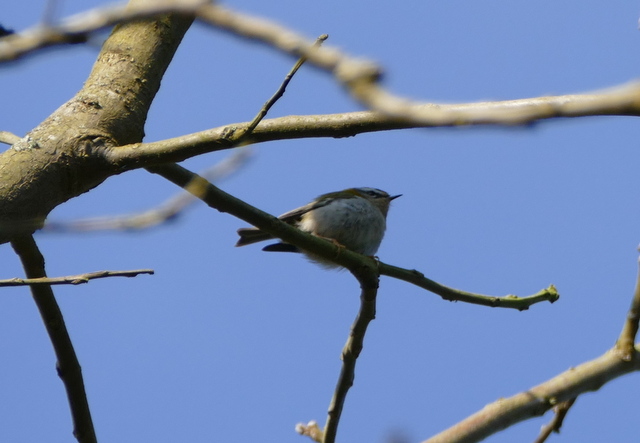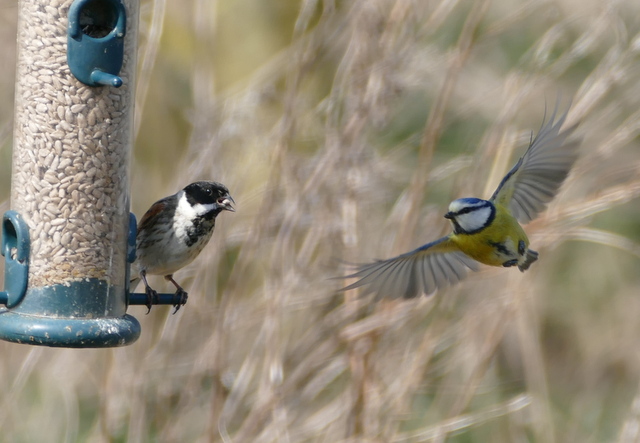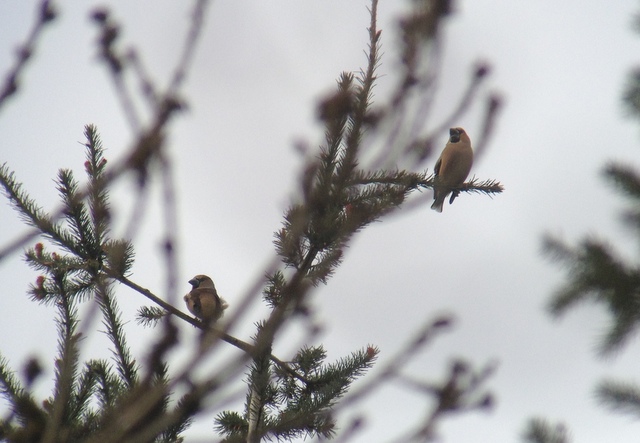Another Brecks Tour today, the last of our scheduled early spring tours to the Thetford Forest area. It was a glorious day of hazy sunshine.
We started at Lynford Arboretum. A Firecrest was singing in the car park as soon as we got out of the car. We picked it up first high in the fir trees, where it was difficult to get everyone onto it, but then it dropped down into a deciduous tree which was only just coming into leaf. Much better! There were lots of other birds in the trees – a Mistle Thrush perched in the top of a larch, a Nuthatch piping from high up in a conifer, several Siskin zipping around the tops calling, and several species of tit.
We walked up to the gate, but there was very little feeding down among the leaves today. No sign of any Brambling – perhaps they have departed in the clear weather over the last few days – just a few Chaffinch. The feeders were empty as well. And no sign of any Hawfinch, so we headed off round the Arboretum.
Another Firecrest was singing in its usual place. This male has been chasing a Goldcrest around for some time now, but today they seemed to have reached a truce. At times, they were feeding close to each other though, almost like a pair. We got a good look at the Firecrest – the striking black and white face stripes and the bronzey patch on the side of the neck. It was also a great opportunity to look more closely at the differences compared to the Goldcrest nearby.
 Firecrest – the same bird photographed recently
Firecrest – the same bird photographed recently
We walked on round the Arboretum and stopped to listen to another two singing Firecrests, one on either side of the path. While we were standing there, we heard the distinctive electric ‘ticking’ call of a Hawfinch and two flew over our heads and back towards the gate. We turned to follow them and hadn’t gone very far when they flew back again and disappeared in the direction of Lynford Hall. We could see the short-tailed, heavy front-ended body shape and the translucent white wing bar, but that was it.
A little further on along the path, we heard more ‘ticking’ and a female Hawfinch flew across right in front of us and into a fir tree. Unfortunately, it was too quick for everyone to get on it as it flew. Even worse, we could see it perched deep in the tree but it was impossible to get all the group onto it and it didn’t stay long enough to get the scope on it. Very frustrating!
We looped back round through the Arboretum via the gate, but it was all still quiet under the trees. It was such a lovely morning we decided to move on and try for Goshawk.
We parked up and walked down a ride into the forest. We hadn’t gone far when we heard yet another Firecrest singing from some young fir trees beside the path. We could see two birds flicking around in the trees, presumably a pair, but it was too thick in there to see them well. A little further on and a Woodlark flew high over the trees and across the ride, singing.
We continued on until we came to a large clearing. It was warm, with mostly blue skies and patchy cloud, but the sunshine was a bit hazy. However, despite the nice weather, there were absolutely no raptors circling up above the trees. We stood and watched for a minute or two, but nothing appeared. So we decided to do a quick circuit of the clearing.
A short distance across, we could hear a Woodlark call and it suddenly appeared from just a short distance in front of us. We watched it circle round, noting its short tail. When it tried to land on a fence post, two more Woodlarks appeared and chased it off, the three of them circling overhead, before the first flew out of their range. When it landed, we had a good look at it in the scope.
Then we walked a little further on and the pair of Woodlark flew up in front of us and landed along the edge of the path. We had great views of them as they fed quietly along the verge – noting the pale supercilia meeting in a shallow ‘v’ on the back of the neck and the distinctive black and white markings on the edge of the wings. We could see they were collecting food and after several minutes they flew past us with their bills full, and landed out in the clearing. Presumably they have young already out there.
 Woodlark – the pair were collecting food today
Woodlark – the pair were collecting food today
The skies were still quiet, but a quick scan of the treeline produced a glimpse of a Goshawk disappearing behind a bank of trees. It was all too quick to get anyone else onto it, and it didn’t reappear. With the general lack of raptor activity, it felt like that might be our only chance. Even more frustrating! But then our luck changed. We had almost given up when it reappeared further round, circling low over the trees behind us. An adult male Goshawk, we could see its pale grey upperparts and whitish underparts, and we got a good sense of its size so close to the trees, before it dropped down out of view.
That opened the flood gates. A Common Buzzard circled up, closely followed by a second. Pretty soon there were several Buzzards up in the sky, in all directions. A young Sparrowhawk circled up in tight spirals and disappeared into the sky. Then another Goshawk appeared over the back of the clearing, this time a young male (in its 2nd calendar year) – browner grey above and orange-toned and streaked below. It circled up for a while, finding a thermal under a Buzzard and giving us a good size comparison, before it drifted off left across the clearing.
That seemed good enough but then, as we were watching a couple of Common Buzzards circle up, yet another Goshawk appeared with them. This one was another adult male – again, with pale grey upperparts and very whitish underparts. We watched it spiral up lazily for ages, with barely a flap of its wings. It already seemed to have its white undertail coverts puffed out and, once it had gained sufficient height, it started displaying – stooping down, closing its wings to swoop back up, and then flapping its wings slowly and deeply in an exaggerated fashion at the top of the climb. It did this repeatedly for a minute or so, in a series of swoops, before turning and dropping down quickly back into the trees. Great to watch.
After that fantastic display, we decided to head for the car. We drove back and found a convenient car park in the forest for lunch. Then it was on to Lakenheath Fen for the first stop of the afternoon. We didn’t have time to explore the whole reserve today, but we wanted to have a quick look at Hockwold Washes. We paused to admire all the Reed Buntings around the feeders by the visitor centre.
 Reed Bunting – on the feeders, with incoming Blue Tit!
Reed Bunting – on the feeders, with incoming Blue Tit!
There were lots of ducks on view from the Washland viewpoint – Shelduck, Gadwall, Teal, Mallard, Shoveler and Tufted Duck. A very smart pair of Great Crested Grebe swam back and forth along the river. A Kingfisher flashed past over the water. A pair of Marsh Harriers circled up distantly over the reserve. But there was no sign of the Great White Egret or the Garganey today. No sign either of any hirundines moving along the river. It was lovely up by the Washes in the sunshine, but we wanted to see some more birds, so we moved on.
We decided to stop at Weeting Heath next. By the entrance to the West Hide, the Long-tailed Tit nest has made good progress since our last visit.
 Long-tailed Tit nest – well camouflaged in the ivy
Long-tailed Tit nest – well camouflaged in the ivy
From the hide, it didn’t take us long to find a Stone Curlew. A good scan produced four, though all a little distant over on the ridge. They were also all asleep, or at least resting. We had a good look at them through the scope and then a wider scan produced yet another Stone Curlew closer to us out to the left of the hide. It was trying to sleep as well! Eventually, one of the more distant Stone Curlews did at least get up and walk around for a bit, before sitting back down again.
 Stone Curlew – trying to sleep, or pretend to be a stone
Stone Curlew – trying to sleep, or pretend to be a stone
On the way back to the car, we stopped to watch a Treecreeper which perched up on the wooden wall of the visitor centre. A closer look and we could see that it was struggling with an absurdly large twig. It dropped to the ground and let go of the stick, before picking it up and trying again. Finally, at its third attempt, it managed to carry the stick up and both bird and burden disappeared behind the NWT sign on the centre wall!
 Treecreeper – carry a big stick!
Treecreeper – carry a big stick!
We were keen to try to see a Hawfinch better, so headed back to Lynford Arboretum before the finish for a last walk round. The Firecrests were still singing, but there was nothing but a few Chaffinches and Siskin down on the ground from the gate.
As we walked round in the Arboretum, we could hear the ‘ticking’ of a Hawfinch once again. But as before, the two birds flew off over our heads as we approached. We walked over in the direction they had come, and again they flew overhead and away towards Lynford Hall. At least we had more flight views.
We decided to explore round the paddocks as a final fling. As we walked down towards the lake, a couple of Grey Wagtails flew over calling. A Little Grebe was hiding among the reeds on the water. Walking out beside the paddocks, a couple of Marsh Tits scolded us from the hedge. At the end, we stopped to admire a Nuthatch piping loudly from an Oak tree.
We walked back round and there was no sign either of the Hawfinches in the trees they like to visit before going to roost – with the evenings drawing out and the clocks having changed, perhaps it was still too early. It just felt like it was not going to be our day. We had packed up and started to leave when we heard them. More ‘ticking’ and two Hawfinches flew in to the trees overhead. We got them in the scope and everyone had a really good look, a male and female, admiring their whopping great bills and chunky heads. Then they dropped down out of view. Wow. Nothing like leaving it to the last minute. What a great way to finish.

















